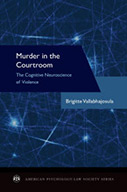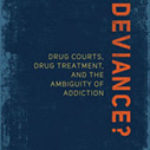Murder in the Courtroom: The Cognitive Neuroscience of Violence

Author: Brigitte Vallabhajosula
Publisher: New York; Oxford, UK: Oxford University Press, 2015. 352p.
Reviewer: Robert D. Mather | September 2015
Cognitive neuroscience has benefited greatly from new neuroimaging techniques of the past 30 years. Though persistent across the course of human history, questions regarding consciousness and free will have recently seen the veil pulled back another notch. Sure, you may feel that you chose to get up and walk across the room yesterday, but what caused that specific brain wave, that specific pattern of detectable electrical activity in the brain, that reliably occurs only right before you become aware that you are about to get up and walk across the room? What triggered the brain activity that led to the conscious thought to get up and move across the room? Such questions of volition make many legal scholars uncomfortable, but we are still humans accountable to each other, and as such, accountable to each other through the court systems. Murder in the Courtroom does an excellent job of evaluating cognitive neuroscience research and demonstrating how it can be used effectively and appropriately in the courtroom, while providing enough information for readers to form their own conclusions about when and what types of neuroscience evidence are appropriate in certain courts in certain circumstances, and how far the conclusions can be taken from such evidence.
In the review Erin McReynolds and I wrote of Douglas Kenrick’s book Sex, Murder, and the Meaning of Life, we suggested that a dynamical systems approach would help to make sense of the complicated social cognitive interplay between humans, and that it would be a particularly beneficial approach to use within the new area of evolutionary forensic psychology research. (Mather, R. D., & McReynolds, E. (2011). From the gutter to the stars: The dynamical system of evolutionary forensic psychology. Evolutionary Psychology, 9, 309-312.)
For example, multidirectional causality is when an effect can alter the thing that caused it, such as a man stealing food because he is hungry, then being arrested and becoming hungrier. In this instance, the hunger caused itself to grow. After reading Murder in the Courtroom, I am convinced that the court system does an excellent job of assessing multidirectional causality in the legal process. Which evidence is allowed, which evidence is disallowed, who is considered an expert, who is not considered an expert, and instructions provided to the jury to disregard information—all of these serve to create a controlled environment in which to evaluate multidirectional causality. Why should cognitive neuroscience evidence be any different in the courtroom than other types of evidence?
The book is usefully organized into three sections (though the author does not list any formal sections as such): Neuroscience (Chapters 2-6), Legal Issues (Chapters 7-9), and Future Directions (Chapters 10-12). Chapter 1 serves as an introduction that draws heavily on the role of consciousness in determining free will.
The Neuroscience section (Chapters 2-6), provides an excellent background for relevant research in the neuroscience literature and draws on reputable research with accurate scientific descriptions of all of the research described. The first four chapters, or approximately 100 pages, are a thorough and appropriate introduction to the human brain. This includes anatomy, physiology, and neuroimaging techniques. In “The Human Brain and Cognition” chapter, the general anatomy of the relevant central nervous system components is described, including basic areas such as the lobes of the cerebral cortex, the hypothalamus, the amygdala, and the cingulate cortex. Additionally, major neurotransmitters and their general effects are described, such as dopamine, serotonin, acetylcholine, and GABA.
Chapter 3 does a great job of highlighting the most relevant neuroimaging techniques, such as computed axial tomography (CT scan), functional magnetic resonance imaging (fMRI), positron emission tomography (PET scan), and psychophysiological techniques such as electroencephalography (EEG), as well as imaging techniques that utilize key neurotransmitters such dopamine and serotonin. There is a useful discussion of when each technique is preferable over the others, such as the trade-offs between fMRI imaging (high temporal resolution) and PET scan (lower temporal resolution) that emphasize structure and function, and EEG recordings (highest temporal resolution, poor structural specificity). Most interesting is the lens through which to evaluate the evidence: the issues and limitations listed, which included neuroimages as post hoc explanations and the imperfection of correlations between violent behavior and brain function. The case of Entertainment Software Association v. Blagojevich (2005) demonstrates how neuroimaging can be challenged in court.
Chapter 4 covers neurological assessment and provides a good explanation on scales, reliability, validity, implications, and legal vulnerabilities of each scale. Beginning with a discussion of Daubert v. Merrell Dow Pharmaceuticals, Inc. (1993), the importance of reliability and validity is emphasized in the discussion of each assessment tool. Many key assessment tools are described, such as the Minnesota Multiphasic Personality Inventory (MMPI), Wisconsin Card Sort Test, Stroop Color and Word Test, Trail Making Test, and the Wechsler Adult Intelligence Scale (WAIS). This section serves as a catalog of tests, information on each, and most important to litigators, the legal vulnerabilities of each. This section is highly valuable to interested legal scholars, and is framed by the perspective that “the ultimate goal of the forensic neuropsychologist is to provide a thorough explanation to the trier of fact rather than an excuse” (p. 95). After distinguishing between instrumental aggression (aggression that is planned to serve a goal) and reactive aggression (aggression that is impulsive and emotion driven), Chapter 5 describes the role of the brain in violence, with particular regard to the amygdala and prefrontal cortex, and their roles in self-control. Chapter 6 describes the legal issues surrounding the development of the adolescent brain, self-control, and volition and a brief discussion of their implications for the application of punishments such as the death penalty.
The Legal Issues section (Chapters 7-9) discusses admissibility, reliability of evidence, and malingering. Chapter 7, “Admissibility of Scientific Evidence,” describes the federal rules of evidence that include preliminary questions, test for relevant evidence, testimony by expert witnesses, and exclusion of relevant evidence, as well as the Frye General Acceptance test and the Daubert Trilogy, and how each of these relates to neuroscience evidence admissibility. Falsifiability and peer review consistently emerge as standards to meet for admissibility of neuroscience evidence. Chapter 8, “Evidentiary Reliability,” describes basic issues of reliability and validity in psychometric testing, as well as the pervasive mistrust of psychological assessments by many legal scholars and the resulting controversy. Chapter 9, “Malingering and its Assessment,” discusses a topic that has generated much discussion in the forensic psychology community, that of malingering, or feigning physical or psychological symptoms to evade criminal conviction, military service, and the like. This chapter outlines criteria required for such classification, including the presence of substantial external incentives, evidence from neuropsychological testing, and evidence from self-reporting. Additionally, detection tools and strategies are discussed for symptoms, personalities, neuroimaging, and psychophysiology.
The Future Directions section (Chapters 10-12) discusses assessing competency to stand trial, cognitive functioning, not guilty by reason of insanity, diminished capacity, and guilty but mentally ill. Definitions and specific case law supporting the controversies are presented. One of the most important issues facing cognitive neuroscience as evidence is the difficulty linking an individual’s brain function and his or her behavior at the point in which a crime occurred.
From the perspective of social cognitive neuroscience, the author includes the correct information necessary for use in evaluating cognitive neuroscience for legal purposes. The most impressive aspect of this book, aside from the presentation of accurate neuroscience research, is that the book integrates important legal evaluations of each assessment scale and imaging technique that is presented. This greatly enhances the utility of the book and makes it unique among textbooks. The information presented in Murder in the Courtroom is information that is valuable for both litigators and forensic psychologists as expert witnesses. It is appropriate reading for law school students, litigators, forensic psychologists, and neuroscientists, who would benefit in the design of future studies from an understanding of how their research might be used in the legal system.
In conclusion, this book is a valuable tool for legal scholars and forensic psychology consultants. Throughout the book, specific case law is discussed to support the cognitive neuroscience research that is presented. Given the concise and accurate discussions of neuropsychological assessment tools and neuroimaging techniques, this volume serves as a catalog for a litigator in need of drawing the most relevant research in cognitive neuroscience, as well as having a list of strengths and vulnerabilities of each.
Robert D. Mather, Ph.D., Professor of Psychology, University of Central Oklahoma


